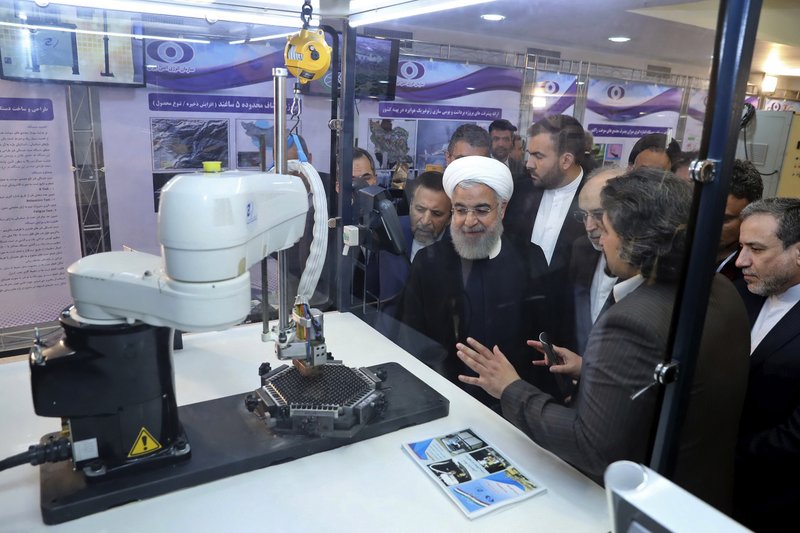As Iran prepares to surpass limits set by its 2015 nuclear deal with world powers, each step it takes narrows the time the country’s leaders would need to have enough highly enriched uranium for an atomic bomb — if they chose to build one.
The United Nations says Iran has so far respected the deal’s terms. But by Thursday, Iran says it will have over 300 kilograms (660 pounds) of low-enriched uranium in its possession, which would mean it had broken out of the atomic accord.
European countries that are still a part of the nuclear accord face a July 7 deadline imposed by Tehran to offer a better deal and long-promised relief from U.S. sanctions, or Iran will also begin enriching its uranium closer to weapons-grade levels.
Breaking the stockpile limit by itself doesn’t radically change the one year experts say Iran would need to have enough material for a bomb. Coupled with increasing enrichment, however, it begins to close that window and hamper any diplomatic efforts at saving the accord.
“I worry about the snowball effect,” said Corey Hinderstein, a vice president at the Washington-based Nuclear Threat Initiative who once led the U.S. Energy Department’s Iran task force. “Iran now takes a step which puts Europe and the other members of the deal in an even-tougher position.”
Under terms of the nuclear deal, Iran agreed to have less than 300 kilograms (661 pounds) of uranium enriched to a maximum of 3.67%. Previously, Iran enriched as high as 20%, which is a short technical step away from reaching weapons-grade levels. It also held up to 10,000 kilograms (22,046 pounds) of the higher-enriched uranium.
Experts who spoke to The Associated Press described the enrichment and stockpile limits in the deal as a sort of sliding scale. Balancing both elements keeps Iran a year away from having enough material for a nuclear weapon, something Iran denies it seeks despite Western concerns about its program.
At the time of the deal, which was agreed to by Iran, the United States, China, Russia, Germany, France and Britain, experts believed Iran needed anywhere from several weeks to three months to have enough material for a bomb.
However, the stockpile limit isn’t an immediate worry from a nonproliferation standpoint, experts say.
“Going over the limit doesn’t immediately signify that Iran has enough material that could — if further enriched and processed — be used in a nuclear weapon,” said Tom Plant, the director of proliferation and nuclear policy at London’s Royal United Services Institute for Defense and Security Studies.
“It does mean that it builds up reserves of material that could in the future support a more rapid push to the higher levels of enrichment that are suitable for weapons use,” Plant said.
The danger comes July 7, if Iran begins enriching uranium to higher levels.
“If Iran begins stockpiling uranium enriched to higher levels, the breakout timeline would decrease more quickly,” said Kelsey Davenport, the director of nonproliferation policy at the Washington-based Arms Control Association.
Both Davenport and Ian Stewart, a professor at King’s College London who runs its antiproliferation studies program called Project Alpha, worry about miscalculations from Iran, the U.S. or the West amid the brinksmanship.
“This highlights the real tension at play in Iran: doing enough to satisfy Iranian hard-liners while also maintaining EU, Chinese and Russian support” for the deal, Stewart said. “There’s a real risk of miscalculating, not least because it’s not clear at which point the EU will have to back away from a noncompliant Iran.”
Davenport says Iran’s moves probably are aimed at gaining leverage in negotiations.
“Even if Iran decided to pursue a nuclear weapon, it would still take months to further enrich and weaponize the uranium,” she said. “It is critical that the United States does not overreact to a stockpile breach and use it as an excuse to further ratchet up tensions in the region.”
A year after President Donald Trump’s unilateral withdrawal from the nuclear deal, the U.S. and Iran are already locked in a volatile standoff. Last week, Iran shot down a U.S. military drone, saying it violated Iranian airspace, though Washington said it was above international waters. The U.S. has blamed Iran for mysterious explosions targeting oil tankers near the Strait of Hormuz. Tehran denied any involvement.
Meanwhile, Israeli Prime Minister Benjamin Netanyahu has vowed to stop Iran from obtaining a nuclear weapon. Israel has bombed nuclear facilities in Iraq and Syria in the past, and reportedly pushed for a similar strike in Iran prior to the 2015 deal.
Iran, for now, allows U.N. inspectors to monitor its nuclear facilities via in-person checks and surveillance cameras. It also has yet to begin widespread use of advanced centrifuges that would speed its enrichment. Experts fear either of those happening.
Once Iran starts going beyond the terms of the nuclear deal, one fact remains indisputable: the time it needs to have enough material for a possible atomic bomb starts dropping.
“As soon as they go over 300 or above 3.67, that number is starting to count down from one year,” Hinderstein warned. “So if they do both, then it’s just going to steepen that line from one year to wherever they end up.”
(AP)











